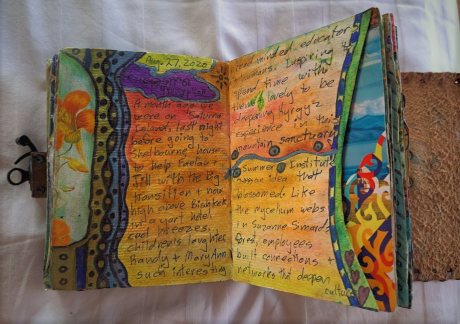21 Writing and Art Journalling for Processing Emotions
“A mental health journal is an interactive tool that allows you to create order out of what often seems like chaos. It allows you to both manage symptoms of mental health challenges and create new life goals and healthy habits. . . . . . When you keep a journal, you take control of the present moment to integrate thoughts and feelings across time and space. As you work in your mental health journal, you can tame racing thoughts and roiling emotions.” – journaling-for-mental-health

Humans have kept written records of their experiences ever since script was developed. Expressing emotions in words is one way of seeing those sensations from a new perspective. Rather than “being” the feeling, you are “seeing” it. This tiny gap of distance can give clarity and self-compassion. Buddhist psychology speaks about getting to know our the “observer” part of our mind that can watch feelings, thoughts and body sensations arise and dissolve. When writing and art are expressing our inner reality, we can access another way of understanding ourselves.
Expressing ourselves through writing or art is one way of creating self-understanding and the “space” that Viktor Frankl spoke about in his famous quote:
“Between stimulus and response there is a space. In that space is our power to choose our response. In our response lies our growth and our freedom.”
Purpose
The purpose of experimenting with journalling, is to explore how self-expression increases self-awareness and clarity.
Learning Objectives
Participants will:
- Explore different kinds of journalling used to express memories, emotions and experiences.
- Choose a journalling method that fits their lifestyle and preferences.
- Observe impacts of journalling on overall self-understanding and stress levels.
Journaling can be as simple as writing down what’s on your mind to record your inner workings and help you better understand your emotions and thoughts.1 Journaling is a powerful tool for organizing your thoughts and making sense of your feelings. Doing so deepens self-reflection so you can grow past the challenges you face.2
While journaling often involves writing your thoughts down on paper in a dedicated notebook or a more formal guided journal, this wellness activity doesn’t have to be limited to pen and paper or written word.
Regardless of format, a mental health journal is an interactive tool that allows you to create order out of what often seems like chaos. It allows you to both manage symptoms of mental health challenges and create new life goals and healthy habits.
Journaling can be helpful when you want to better understand your past and make sense of your experiences. It can also help you become unstuck by providing clarity that leads to specific actions. For example, you might decide to seek extra support, leave or deepen a relationship, or pursue a dream.
Note: This article provides a thorough exploration of ways to use journalling specifically for anxiety, depression and stress. It also includes a list of prompts that might help someone journalling to get started with expressing their thoughts, memories and feelings. These prompts could also be used for in-session group explorations and participants could choose one small passage from their journal entry to share in small groups. Reading personal writing out loud creates a different relationship with the words and meaning. It is a vulnerable act, and can often bring a group closer as they understand someone from a new perspective.
Activity Directions
- Choose a journalling method: Encourage participants to choose a journalling method that works for them to record their experiences, insights and emotions. Some people like the physicality of pen and paper and others like the convenience and freedom of digital journalling. Allow some class or workshop time for them to reflect and write. Ask them to develop a journalling habit for a month and then report back on the impact of journalling on their overall wellbeing.
- Optional sharing: Journalling is private and sharing should be optional. Sometimes some people like to share their creations. If there are a few volunteers that are willing to share their reflections, it can be helpful to the speaker to say their words out loud to a supportive audience and it can also be helpful to the listeners as there is often a sense of shared humanity in the themes that are expressed.
Here are a few ways to journal:
- Have a book that looks and feels good to you. Develop a daily writing practice that captures your moods, experiences, dreams and goals.
- Use your computer (a Word doc or a web-based service like Google Docs) to record thoughts and feelings.
- Smartphone apps
- Record your thoughts as an audio journal
- Make a video journal (you might talk to the camera, record your surroundings and objects that represent your thoughts and feelings, or both)
- Create an art journal that focuses on visual images through drawing, scribbling, collaging and painting to express emotions and experiences.
- Take a daily photo that shows your emotions for that day. At the end of each month, take a few moments to look through your photo journal and reflect on the themes and moods it has captured. You might want to do some writing based on the photos that reflect your insights into the pictures and patterns you notice.
- Launch a personal blog or vlog or substack that shares your journalling process with others.
For more info on the benefits and practicalities of journalling read Tanya Peterson’s article:
